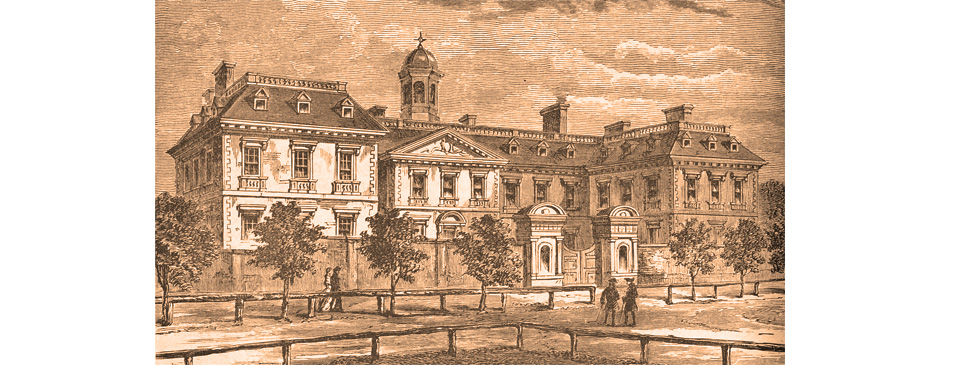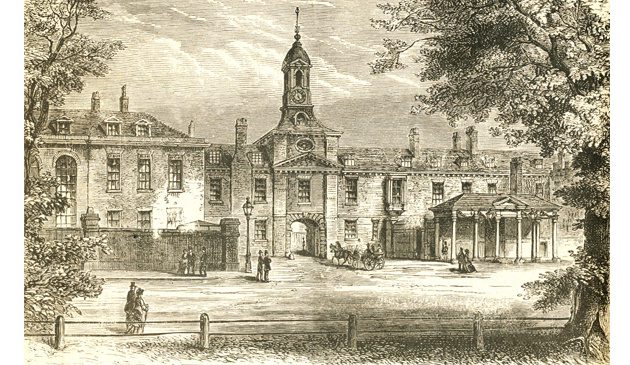The westward growth of London in the 17th century

A 19th century artist’s impression of the Lord Chancellor’s grand mansion Clarendon House on Piccadilly, facing towards St.James’s Palace, in the 1660s. Despite its huge cost it stood for less than twenty years before making way for the new development of Bond Street and Albermarle Street.
For a short time one of the finest houses in Bloomsbury, other than that of the Earl, was Montague House, built by Robert Hooke for Ralph Montagu, a relation of Southampton through marriage. It was completed in around 1670 but burned to the ground after just fifteen years and replaced by another that would eventually become the British Museum.
Covent Garden was initially created as merely housing of a similar size and type together with a church. Southampton realised the need for a number of properties of various sizes and quality in different streets, as well as a market to be included as part of his development for the convenience of the residents. The diarist John Evelyn described the Bloomsbury development as a “little town”.
The Earl of Southampton died in 1667 and Bloomsbury was eventually inherited by his grandson who also took the title of his grandfather on his mother’s side, the Duke of Bedford, together with his estate, thus merging the ownership of Bloomsbury and Covent Garden. The new Duke and Duchess demolished the former Duke of Bedford’s house that stood between the Strand and one side of the Covent Garden piazza and moved to the larger family home at Bloomsbury, which was renamed Bedford House. The Covent Garden home was replaced by houses in 1673 in the new Burleigh and Exeter Streets.
The origin of Piccadilly can be traced back to the early 17th century milliner Robert Baker, who built Piccadilly Hall at what is now Great Windmill Street where he had made his fortune selling fashionable ‘picadil’ collars. After his death his widow Mary began to build on the surrounding fields.
The country lane that stretched away to the west of Piccadilly Hall towards the villages of Knightsbridge and Kensington began to be developed in the mid-17th century. It was then named Portugal Street after the country of Queen Catherine’s birth but would be renamed Piccadilly in the 18th century.
Edward Hyde, Earl of Clarendon, had been rewarded with the post of Lord Chancellor and thirty acres of land to the north of Portugal Street, for his part in restoring Charles II to the throne. In 1664 he began building the magnificent Clarendon House on the land, designed by Sir Roger Pratt, and facing across the street down the hill towards St.James’s Palace. It took three hundred men to build at a cost of fifty thousand pounds and was described by Samuel Pepys as “a beautiful house – most strongly built in every aspect” with “the noblest prospect that ever I saw in my life, Greenwich being nothing to it”. On his visit in 1669 the Duke of Tuscany found that it “is in an advantageous situation, which increases its magnificence, being in front of a wide street, leading down to St.James’s Palace, which is directly opposite to it. Its form is square; on the outside, from being embellished with stone ornaments, regularly disposed according to the rules of architecture, it is extremely light and cheerful, and in the interior, commodious and sumptuous. From the inner part you descend into the garden, surrounded, in its whole extent, by walls, which support flourishing espaliers, formed of various fruit trees; these render the view very agreeable…At present, this house, in consequence of the contumacy of the lord chancellor, who has been banished from the kingdom, is incorporated with the royal domains, and is at the king’s disposal.”
Five years later Clarendon House was sold to the Duke of Albemarle for half what it had cost to build and who was himself forced to put it up for auction to pay his debts. It was bought by a consortium of bankers including Sir Thomas Bond, Henry Jermyn and Margaret Stafford for thirty six thousand pounds and they demolished it in 1683 to sell the materials at a profit. They initially planned to develop a square similar to St.James’s but instead Bond and Richard Frith laid out Bond Street and Albemarle Street with a new development on what had previously been the gardens of the house. (Bond Street originally only stretched as far north as Burlington Gardens, extended to Oxford Street in the 1720s).


